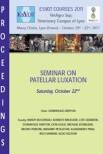Lameness and hock injuries are recognized welfare and production problems in the dairy industry. The objective of this study was to describe changes in the prevalence of these ailments in 15 freestall herds in the Northeastern United States that participated in an on-farm assessment program. Prevalence was assessed in a high-producing pen in each herd. A confidential report was delivered to each of the farms showing prevalence in relation to other herds assessed within the same region.
The average (±SD) period between visits was 11.5 ± 4.4 months (range, 8–25 months). The prevalence of lameness decreased in most herds after the first assessment (mean difference ± SE [range] = −17 ± 4 % [−43 to 6]). An even larger improvement was seen in the prevalence of hock injuries with all farms showing a decrease (−38 ± 6% [−1 to −87]). The degree of improvement observed at the second assessment was greatest for those farms that had higher lameness prevalence when first assessed, but this was not the case for hock injuries. The changes in prevalence of clinical lameness and overall hock lesions were, however, correlated (ρ = 0.62).
These results suggest that monitoring and reporting the prevalence of lameness and hock injuries to farmers can motivate changes in facilities and management targeted to address these ailments.









